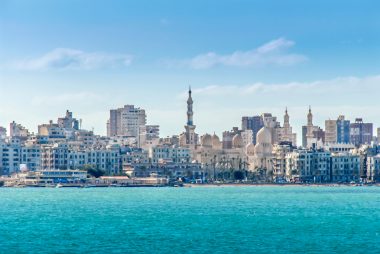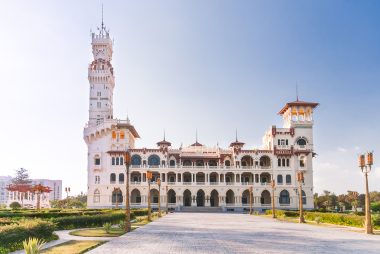Alexandria – when you mention this name, several things come to mind: the lighthouse, the library, the sea, Alexander the Great…
Alexandria and its namesake
When Alexander the Great founded the city of Alexandria on April 2, 331 BC, the current city area had already been inhabited for about 2000 years. The city probably already had port facilities at that time. However, fundamental changes were made in the city, which were not completed until between 285 and 246 BC.
In the year of its founding, Alexander the Great moved on and never returned to the city alive. His body, however, was brought back to the city and presumably buried there in the royal mausoleum.
On his campaign of conquest, Alexander the Great had founded many Alexandrias. However, only that city in Egypt has retained its name.
Attractions in Alexandria
Qāitbāy Citadel: Military Base

After two years of construction, the citadel was completed in 1479. It stands on the ruins of the old lighthouse of Alexandria, which is considered the first lighthouse in history. Its foundation was also built into the Qāitbāy Citadel.
The building was built as a protection against the Ottomans, but in 1517 it was nevertheless conquered by Selim I and from then on used as a military base of the Ottoman Empire, but lost its importance.
In 1798 it was conquered by Napoleon Bonaparte. Six years later, the citadel was renovated and brought up to date militarily. At the end of the 19th century, the building suffered great damage due to a bombing by the British, but from 1904 onwards the building was rebuilt at the suggestion of the Ministry of Defence.
Since the 1950s, the Qāitbāy Citadel has housed a naval museum and a mosque is now part of the complex.
Montaza Palace: Royal Fairytale Palace
The Montaza Palace resembles a fairytale castle. The building is one of the newer ones in the city. It was built from 1923 to 1928 by Ernesto Verrucci for the ruler Fu’ad I as a summer residence in the style of eclecticism.
Typical of this, the building is characterized by the combination of different styles of past times. The Montaza Palace is a mixture of Ottoman and Florentine architectural styles and has two towers that are unequal in height. The higher of the two is a good indication of the Italian Renaissance as an inspiration.
The Royal Gardens, now called Al-Montaza Park, which extend around the building, are open to the public. The palace itself can also be visited. It is now used as a public museum for art objects and the family history of the Muhammad Ali dynasty. The older Salamlek Palace, which has stood on the site since 1892, currently functions as a hotel.
Catacombs of Kom ash-Shuqafa: Facing Death

The catacombs of Alexandria are dated back to the 2nd century AD and are now an archaeological site.
In the necropolis there are tombs as well as statues and archaeological objects of the pharaonic funerary cult. However, it also has Hellenistic and Roman influences and is a real melting pot of cultures. Thus, the statues often combine characteristics of different cultures.
The catacombs were only in use from the 2nd to the 4th century. After that, their existence was forgotten and it was not until 1900 that they were accidentally rediscovered.
A special attribute of the necropolis is the Hall of Caracalla, which contains the bones of the horses of the Emperor Caracalle.
Greco-Roman Museum Alexandria: a historical collection
Among the museum’s exhibits are statues, mummies and sarcophagi. It deals with Roman and Greek art in Egypt. Thousands of the pieces date back to the 3rd century BC, but the dating of the pieces dates back to the 3rd century AD.
The collection is mainly made up of donations and pieces that came to light during excavations in and around the city.
The museum was founded in 1895 and was closed in 2005 due to renovation work.
Bibliotheca Alexandrina: In the Shadow of His Ancestor
In ancient times, Alexandria was known for its extensive library. After it burned down, however, it was only a nice memory.
In 2002, a modern library was opened near its original location.
The reading room takes up about half of the building and is the largest in the world with 2000 seats. The library offers space for 8 million books, but only a fraction of the space is used due to the lack of financial resources


